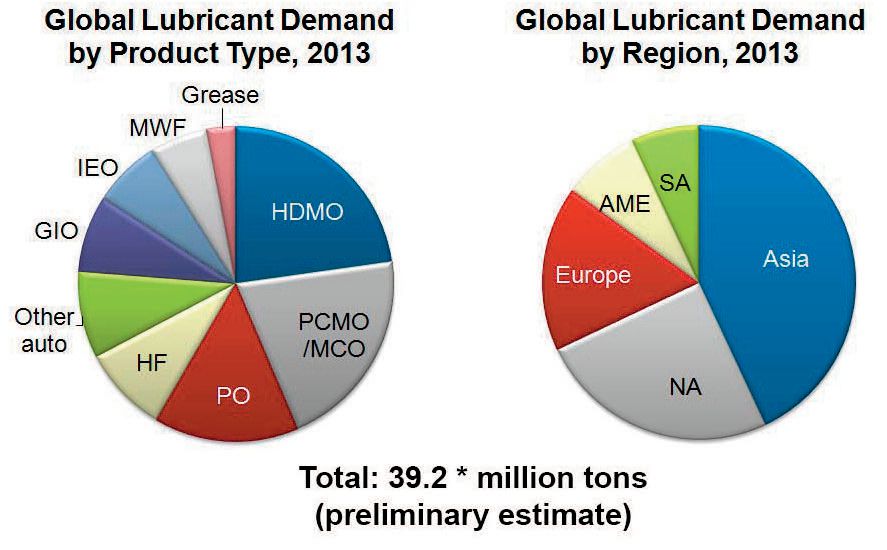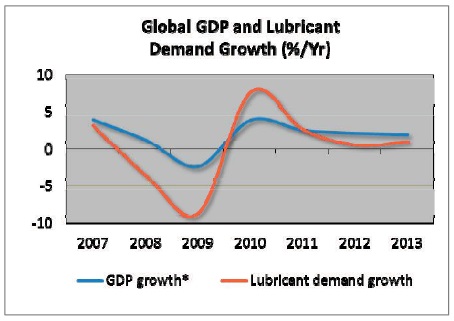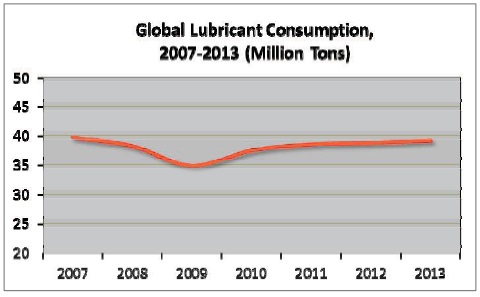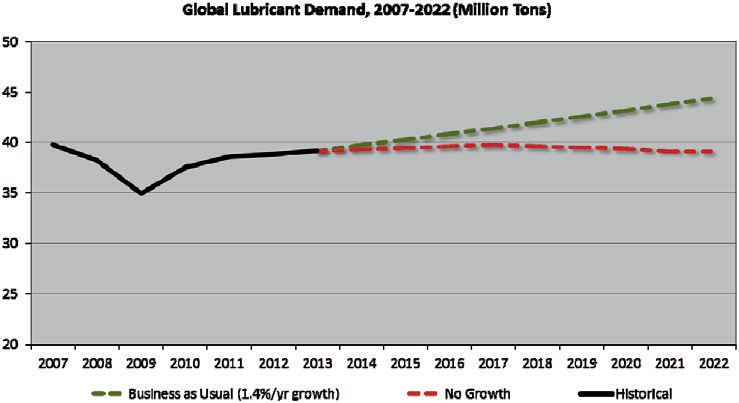The global lubricants market: Quality bonanza ahead?
Milind Phadke | TLT Market Trends June 2014
While demand has returned to pre-recession levels, the marketplace is dramatically different and still changing.
KEY CONCEPTS
•
The 2013 global lubricants marketplace is estimated at more than 39 million tons.
•
Lubricant demand generally tracks the trend line for a nation's gross domestic product.
•
For at least the next five years, lubricant demand looks to stay in a no-growth or low-growth state.
AFTER A FIVE-YEAR ROLLER COASTER RIDE, the global lubricant market in 2013 is back to where it was in 2007. So does this signify a return to normal?
This article argues that the lubricant market in 2013 is dramatically different from the market in 2007. While the market is now in a low- or no-growth state, the potential for quality improvements is immense.
The global lubricant demand in 2013, as per Kline’s preliminary estimates, is 39.2 million tons. This represents a 1 percent growth over 2012. Figure 1 provides a split of the global lubricant demand by product types and regions.
 Figure 1. Global lubricant demand (Kline & Co.)
Figure 1. Global lubricant demand (Kline & Co.)
Automotive lubricants account for about 52 percent of the total demand. The leading automotive products include heavy-duty motor oils (HDMO), passenger car motor oils (PCMO) and motorcycle engine oils (MCO). Together, these three products account for 43 percent of global demand. Other automotive products include automotive gear oils, automatic transmission fluids, tractor hydraulic fluids and automotive grease. Industrial lubricants account for 48 percent of the total demand. Process oils, hydraulic fluids and other general industrial oils are the leading industrial lubricant categories. Together, they account for 32 percent of the total demand.
Asia-Pacific is the largest lubricant consuming region accounting for 43 percent of global demand. Six of the top 10 markets are in Asia-Pacific: China, India, Japan, South Korea, Indonesia and Thailand. The Americas region accounts for 32 percent of the global demand. The United States, the second largest lubricant market in the world, accounts for 66 percent of the region. Europe, which includes western and eastern Europe, Russia and Turkey, accounts for 17 percent of regional demand.
The global lubricant market has seen significant upheaval in the last five years. As shown in Figure 2, the year-on-year lubricant demand growth has generally tracked GDP growth, though with wider swings.
 Figure 2. Lubricant demand growth (Kline & Co.)
Figure 2. Lubricant demand growth (Kline & Co.)
Lubricant consumption permeates every aspect of modern life, including personal mobility, goods transportation, construction, mechanized agriculture, mining and modern manufacturing. In fact, as countries modernize and industrialize, their per-capita lubricant consumption increases, although at a slower rate. So it is no surprise that lubricant consumption tracks GDP growth. What, however, explains the wider swings in lubricant demand?
For one thing, the sensitivity of lubricant growth to economic growth is different in different countries. For rich countries with stable vehicle populations and manufacturing capacity, the sensitivity to economic growth is lower compared to developing countries. Second, the lubricants industry has a long supply chain from basestock suppliers to blenders to lubricant installers to car owners. Production levels are set by market sentiment on where consumption is headed. Consequently, the industry experienced a huge reduction in inventory levels at all stages of the supply chain, causing a significant contraction in lubricant demand in 2009 and the opposite in 2010.
With this growth history, the global lubricant demand in 2013 is back to the consumption levels of 2007, as shown in Figure 3.
 Figure 3. Global lubricant consumption (Kline & Co.)
Figure 3. Global lubricant consumption (Kline & Co.)
While things seem to be back to where they were in 2007, a number of changes have taken place under the surface. Asian share in global lubricant demand has increased from 33 percent in 2007 to 43 percent in 2012. North America and Europe have shown a similar drop in their share of global demand over this period. This is hardly surprising given the disparity of growth rates between rich countries and developing nations. Therefore, the global lubricant market has a much higher dependence on Asia-Pacific, and any slowdown that might happen here will have a bigger impact overall.
Another important change has been the rapid improvement in quality of lubricants consumed. A useful proxy to capture this quality improvement is the relative consumption of different lubricant basestocks. The share of API Group I basestocks has declined from 68 percent in 2007 to almost 54 percent in 2012. The drop in Group I has been offset by an increase in Group II and Group III basestocks. This has resulted in quality improvements, even in lowquality markets. In many Asian markets, PCMO viscosity grades have leapfrogged to the latest viscosity grades due to the availability of high quality basestocks.
The lubricant market in 2013 only superficially resembles the market in 2007. More important, on both the growth and the quality front, the global market in 2013 is likely to behave differently from the past.
The first major difference between 2013 and 2007 is the economic outlook for developed and developing nations. Both North America and the European Union have an improved economic outlook. As per projections by The Economist Intelligence Unit (
www.eiu.com), growth rate in North America will improve from 1.9 percent in 2013 to 2.6 percent in 2014 and should stay at this level over the next five years. The EU will see its growth rate improve from 0.2 percent in 2013 to 1.5 percent in 2014 and is again expected to stay at this level during the next five years.
However, this time the Asian countries are the source of economic weakness. China is reorienting its economy away from export-led growth to consumption-led growth. This transition is proving difficult. In 2012, an attempt by the government to control the emerging property bubble led to a severe contraction in construction, mining and related industries. The property bubble itself was a result of the high salary levels and easy money policy followed by the Chinese government to stimulate domestic consumption. More such shocks may be in store as the country reduces its dependence on export-led growth. In the future, China is likely to target a lower economic growth rate since employment generation is no longer a priority given the aging population. The EIU projects a growth rate of 6 to 7 percent for China for the next five years in contrast to the double-digit growth in the years leading up to the recession.
For other Asian countries, and in particular India and Indonesia, risk of economic downturn looms. This is due to the dependence on foreign money and inevitable tapering of bond purchases by the U.S. Federal Bank, which results in an easy money supply. The very talk of this tapering has reduced Indian GDP growth to 3.3 percent in 2012 and 4.9 percent in 2013. This is a huge drop from a growth of 10.5 percent in 2010. India along with Indonesia, Brazil, South Africa and Turkey have been called the Fragile Five—perhaps unfairly since they are unlikely to precipitate another global recession.
The moderate recovery in North America and Europe will not be enough to compensate for the reduced growth in Asia-Pacific. Hence the overall growth outlook is much lower in 2013 as compared to 2007. Besides economic conditions, there are three other trends which will dampen lubricant demand growth. All of these trends were in play before the recession, but the recession simply accelerated them.
First, the huge surplus of high-quality basestocks makes it inevitable that oil drain intervals will extend due to competitive pressures between automotive OEMs and oil companies. Companies in both industries are and will continue to trumpet lower maintenance costs of longer oil drain intervals to cost-conscious consumers.
Second, there will be greater penetration of smaller vehicles and hybrid and electric vehicles in the overall population. This will depress lubricant consumption compared to the growth in the vehicle population.
Third, in Western countries car ownership and driving is reducing, and car sharing as a concept is growing. Though small now, this dynamic could have a significant impact in the future.
The net impact of these trends and the economic outlook on the lubricant demand is depicted in Figure 4 in form of alternate scenarios.
 Figure 4. Global lubricant demand (Kline & Co.)
Figure 4. Global lubricant demand (Kline & Co.)
Given the changes in the market discussed above, growth at the historically observed 1.4 percent per year is probably difficult to achieve. On the other hand, it is unlikely that the market will contract from 2013 consumption levels. Making reasonable estimates for vehicle population growth, changes in oil drain intervals, penetration of small vehicles and hybrids and other such factors leads to the conclusion that the market will flatten out over the next 10 years.
The story of lubricant demand growth is an old one—is the glass half full or half empty? While the global demand is unlikely to grow at a strong pace, at least demand is not contracting. Conversely, on the quality front, the news is somewhat less ambiguous. Asia-Pacific and China, in particular, have interesting developments, which bode well for quality improvement.
Between 2000 and 2010, total energy consumption in China doubled and increased by 50 percent in India. This is due to massive growth in manufacturing capacity in the two countries. For example, steel production capacity in China grew by a factor of 4.5 and a factor of 1.9 in India. This rapid modernization has been accompanied by environmental degradation. Carbon dioxide emissions in China and India grew by a factor of 1.3 and 0.7, respectively, in the last 10 years. Water quality also has degraded and water scarcity increased during this period. Environmental concerns trump consumer concerns in both countries.
Multiple smog incidents in 2013 raised awareness about environmental degradation and forced the Chinese government to finally pay attention to this issue, and, as a result, the Chinese government announced significant spending plans for environmental remediation. Future projects will have a tougher hurdle on environmental factors, which bodes well for lubricant quality improvements.
Besides environmental factors, Chinese and other Asian exporters have competitive reasons to improve the quality of their processes. Chinese manufacturers are moving up the value chain and seeking to compete with Western counterparts. Currency appreciation and increasing wage levels have eroded their low cost position.
To compete, Chinese manufacturers have to focus on improving quality. The recent forays by Chinese and Indian auto companies in Europe and North America have not been successful, and the key reason is the poor quality image associated with these OEMs. Given the internationalization strategy followed by these OEMs, they will have to improve quality perceptions, which again bodes well in improving lubricant quality.
Finally, the anticipated deluge of high-quality lubricant basestocks will act as a spur for lubricant quality improvements. Judging by industry announcements, the following scenarios are likely:
•
The supply of high-performance Group II and Group III basestocks will grow by 10 million tons over the next 10 years.
•
More interestingly, the Asian share of global Group III production will drop from 74 percent in 2012 to around 30 percent in 2022.
•
North American and European share in global Group III supply likely will increase from 5 to 13 percent and 22 to 26 percent, respectively, between 2012 and 2022.
•
Middle East, which did not produce any Group III a few years ago, will account for close to 30 percent of the global supply by 2022.
•
Asia-Pacific will go from being a global supplier of Group III to merely another region with a high-performance basestocks supply. Asian Group III suppliers will be at a disadvantage compared to their rivals in Europe and North America, and, as a result, much of the Group III produced in Asia-Pacific will be consumed in Asia-Pacific, leading to rapid improvement in lubricant quality.
In summary, the global lubricant market in 2013 is significantly different from the pre-recession market. Overall growth has slowed down due to low growth in Asia-Pacific and moderate recovery in Europe and North America. Technological and socio- economic factors will also continue to dampen lubricant demand growth. However, in general, lubricant demand is unlikely to see a significant contraction. Environmental factors, competitive pressures, and increasing supply of high-quality basestocks will drive rapid improvement in lubricant quality in developing economies, and, in particular, Asia-Pacific.
 Milind Phadke is a director at Kline & Co. in the Energy practice. Based in Kline’s India office, he is responsible for the company’s syndicated market research reports in the areas of finished lubricants, lubricant basestocks and lubricant additives. You can reach him at milind.phadke@klinegroup.com
Milind Phadke is a director at Kline & Co. in the Energy practice. Based in Kline’s India office, he is responsible for the company’s syndicated market research reports in the areas of finished lubricants, lubricant basestocks and lubricant additives. You can reach him at milind.phadke@klinegroup.com.